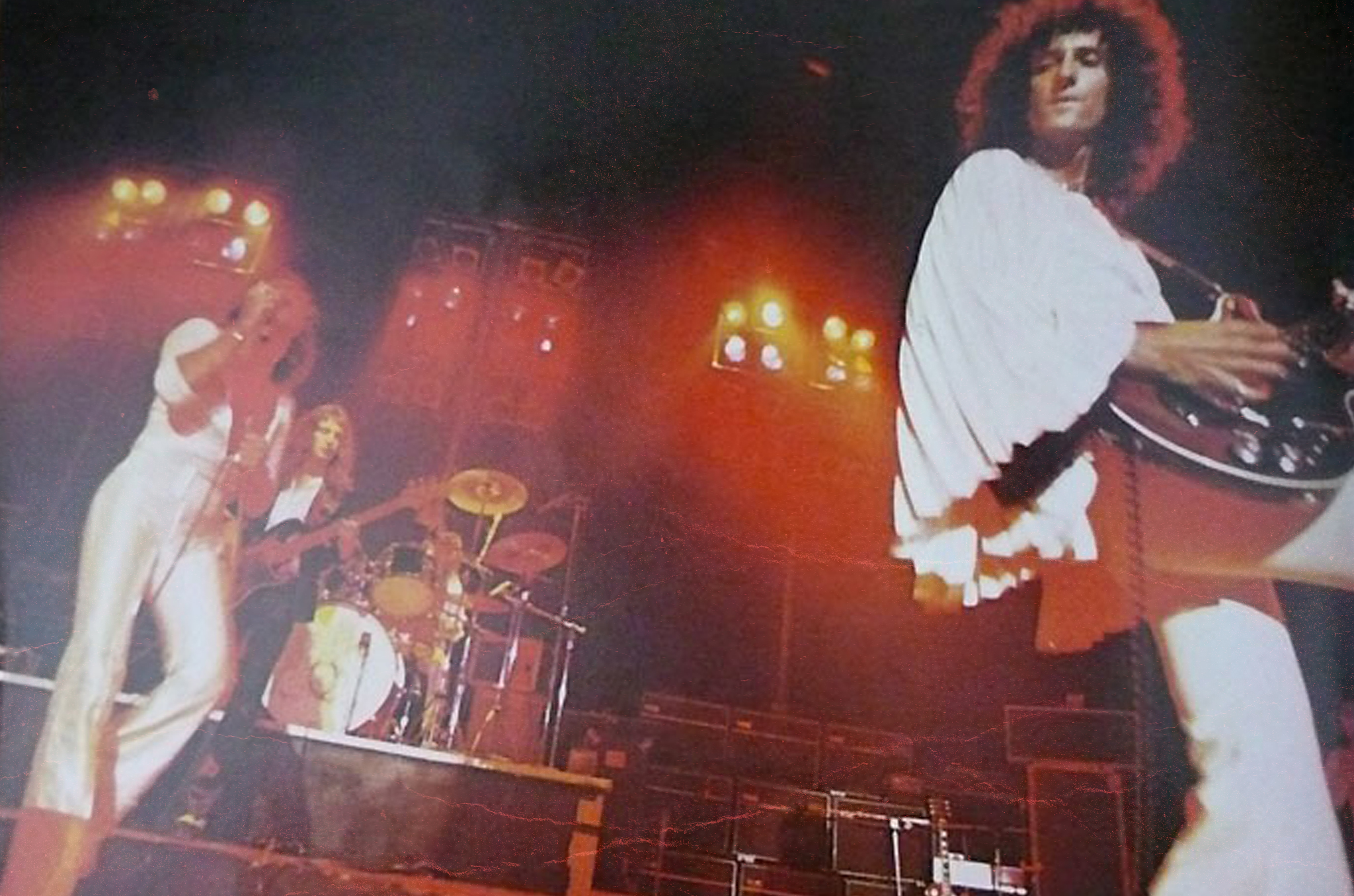On this day 50 years ago, over 1,000 (some sources say as many as 3,000) fans greeted Queen when its members arrived at Haneda Airport in Tokyo ahead of its first-ever Asian tour. They played eight shows in seven cities here, starting at the Nippon Budokan, which had been built just over a decade earlier for the inaugural judo competition at the 1964 Tokyo Summer Olympics. It was the beginning of a deep connection between the band and Japan, where Queen Day, celebrated by fans every April 17, is officially recognized by the Japan Anniversary Association.

Image © Koh Hasebe
From Support Act to Headliners
In December 1974, a few months before the tour, Queen featured on the cover of the Japanese magazine Music Life. Kaoruko Togo, a former editor-in-chief of the publication, arranged an interview with the group after meeting Roger Taylor and John Deacon at a restaurant in New York. At the time, they were in the city as a support act for British rock band Mott the Hoople. Togo saw Queen perform and was convinced they would be a hit with Japanese women. She certainly wasn’t wrong.
After touring with Mott the Hoople, Queen started working on its third album, Sheer Heart Attack, which was released in November 1974. Featuring the single “Killer Queen,” the album reached number two in the UK, sold well throughout Europe and went gold in the US. Four years after forming, the band was starting to enjoy some international success. The reaction they got in Japan, however, still shocked them. Up until then, they had never received that kind of reception at an airport.
The 2019 book, Queen Live Tour in Japan 1975-1985 — which has notes originally published by Music Life — described the commotion when they arrived. “The group is swarmed by fans and their high-pitched, happy screams. The fans pull the members’ hair and clothes, and the members even feel concerned for their personal safety … Upon arriving at the Tokyo Prince Hotel, they are greeted by another 100 fans or so, causing a noisy scene in the lobby. The members are taken to their rooms on the sixth floor, bringing the chaos to a conclusion.”

Queen at the Tokyo Budokan, 1975 | brianmay.com
Live at the Budokan
Two days later, the band played its first concert in Japan at the Budokan, the same venue the Beatles famously performed at nine years earlier. The four members were informed that Japanese audiences were quiet and would stay in their seats during the gig. The reality, however, was very different. At one point, singer Freddie Mercury even had to ask the boisterous fans for calm. The show, which began with “Now I’m Here” and finished with “See What a Fool I’ve Been,” was a huge success.
The following day, the band enjoyed a tea ceremony in front of Tokyo Tower. Koh Hasebe, the first Japanese photographer to capture the Fab Four, photographed the scene as they sat with women dressed in kimono. After filming a TV spot that night, they then traveled to Nagoya the next morning for their second gig. Mercury, Deacon and Taylor enjoyed some sightseeing at Nagoya Castle before the show, which included a short rendition of the Japanese nursery rhyme “Teru Teru Bozu,” performed by May.
Their next concert was in Kobe, which was followed by a sightseeing trip to Kyoto, where Mercury bought a maneki-neko (beckoning cat statue), while the other three played pachinko. Later that night, Queen headed for Fukuoka, where the crowd was particularly raucous. After that, they traveled to Okayama, Kakegawa and Yokohama, before returning to Tokyo to perform at the Budokan again. They departed Japan on May 2. Five days later, Queen Elizabeth II and her husband, Prince Philip, Duke of Edinburgh, arrived at Haneda Airport.

Image © Koh Hasebe
Queen’s Warm Ties With Japan
That was the queen’s only official visit to Japan. Queen the band, on the other hand, returned five more times, with its last tour here with Mercury as the singer coming in 1985. According to Greg Brooks, Queen’s official archivist, “All of the band fell in love with Japan.” To show appreciation for the support it received in this country, Queen closed its 1976 album, A Day at the Races, with the song “Teo Torriatte (Let Us Cling Together),” which has two choruses in Japanese.
Kaz Utsunomiya, a concert promoter and friend of the band, believed Queen took a different approach to other groups, which had a long-lasting impact on fans here. “A lot of international bands come to Japan, they go to Tokyo and Osaka, right? Rarely have a chance to see the culture outside Tokyo, which this band did from day one … That helped the band understand Japanese culture, Japanese history and sort of like meeting Japanese fans,” he said.
The fans here have appreciated the group ever since and remain loyal to them. On this day a decade ago, a special event was held at Tiat Sky Hall in Haneda Airport to celebrate the 40th anniversary of Queen’s arrival in Japan. It featured panel discussions with Japanese people who were part of the band’s tours here, in addition to Queen tribute acts. Celebrations of the band aren’t limited to major anniversaries — Queen Day is commemorated every year with special events, including screenings of the band’s music and films.
More From This Series


AloJapan.com